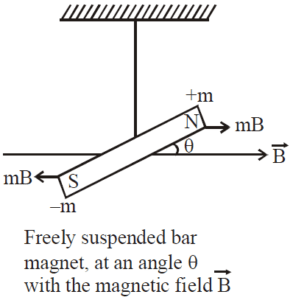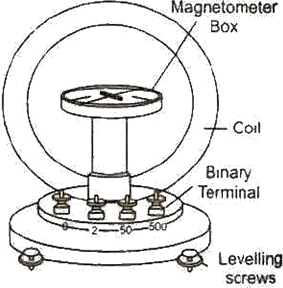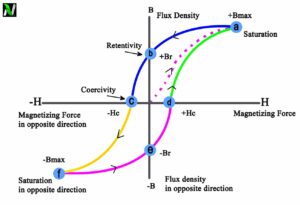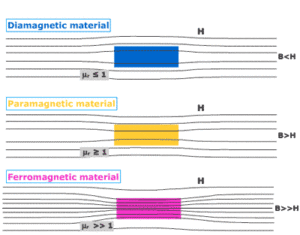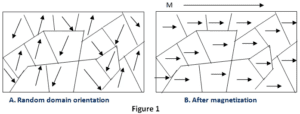Gauss Law for Magnetism class 12
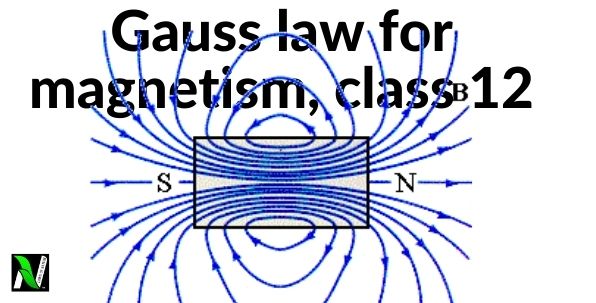
In this article, we will discuss Gauss’s law for magnetism class 12, statement, derivation, and law in differential form and Integral form. So let’s get started…
Gauss’s law for magnetism is one of the four equations of Scottish mathematician James Clerk Maxwell. This law is the base of classical electrodynamics.
Previously we have talked about Gauss’s law for electrostatic. In electrostatic, gauss law states that the surface Integral of the electrostatic field $(\vec{E})$ over a closed surface $S$ is equal to $\frac{1}{\epsilon_0}$ times the total charge enclosed within the closed surface $S$. Mathematically, it is expressed as: $$\oint_S{\vec{E}\cdot \overrightarrow{dS}}=\frac{q}{\epsilon_0}$$
Gauss law for magnetism statement
Gauss law for magnetism states that the magnetic field B has divergence equal to zero, in other words, this law can be stated as: it is a solenoidal vector field. A solenoidal vector field is a vector field v which have the divergence zero at all points in the field.
Gauss law for Magnetism class 12 explanation
Let’s suppose that the closed surface $S$ encloses an electric dipole that consists of two equal and opposite charges. The total charge enclosed by the surface $S$ is zero so that the surface Integral of the electrostatic field of an electric dipole over a closed surface is also zero i.e $$\oint_S{\vec{E}_{dipole}\cdot \overrightarrow{dS}}=0$$
We know that the magnetic field is only produced by the magnetic dipole because isolated magnetic poles (monopoles) did not exist. The total magnetic charge enclosed by the surface $S$ is zero so that the surface Integral of the magnetic field of a magnetic dipole over a closed surface is also zero i.e $$\oint_S{\vec{B}\cdot \overrightarrow{dS}}=0$$
So this is the Gauss law for magnetism which states that the surface Integral of a magnetic field over a closed surface is always zero.
| More to know: The surface Integral of the magnetic field over a closed surface gives the magnetic flux through that surface. |
Gauss’s law for magnetism is the formal way to express the statement that magnetic monopoles do not exist. Rather than the “magnetic charges”, the basic entity for magnetism is the magnetic dipole.
Different Forms of gauss law for Magnetism
Gauss’s law for magnetism can be written in two forms i.e. differential forms and integral forms. These two forms of Gauss’s law are equivalent due to the divergence theorem.
| More to know: You will be surprised to know that the name “Gauss’s Law for Magnetism” is not widely used. This law is also called the “absence of free magnetic poles” because this law indirectly states that magnetic monopoles did not exist. Some sources even say that the law has no name. It is “nameless”. Since plane waves require polarization transversely to the direction of propagation, this is also referred to as a “transverse requirement”. |
Differential form of Gauss’s law for magnetism
In differential form, gauss’s law for magnetism can be given as $${\displaystyle \nabla \cdot \mathbf {B} =0}=0$$ where $\nabla\cdot$ denotes divergence and B is the magnetic field.
The integral form of Gauss’s law for magnetism
In integral form, gauss’s law for magnetism is given as: $$\iint_S{\displaystyle \mathbf {B} \cdot \mathrm {d} \mathbf {S} =0}$$
where $S$ is any closed surface and $d\mathbf{S}$ is a vector whose magnitude is the area of an infinitesimal part of surface S and whose direction is the normal of the outward-facing surface.
The left-hand side of this equation is called the net flux of the magnetic field from the surface, and Gaussian law for magnetism says that it is always zero. The integral and differential forms of Gauss’s law for magnetism are mathematically equivalent because of the theorem of divergence.
The law in this form says that for each volume element in space exactly the same number of “magnetic field lines” enter and exit the volume. You cannot accumulate a total “magnetic charge” at any point in space.
For example, the south pole of the magnet is just as strong as the north pole, and the free-floating south poles without the association of the north pole (magnetic monopoles) didn’t exist, but on the other hand, this is not applicable for other fields such as electric fields or gravitational fields, in which the entire electric charge or mass is in can accumulate in a volume of space.
Derivation of Gauss’s law for magnetism
In this section, we will derive Gauss’s law for magnetism in differential form in two ways.
- By using the divergence theorem
- By using biot-savart law
Derivation using the divergence theorem
The Gauss law for magnetic fields in the differential form can be derived by using the divergence theorem. According to the divergence theorem: $$ \iiint _{V}(\mathbf {\nabla } \cdot \mathbf {F})\,\mathrm {d} V=\iint_{S} (\mathbf {F} \cdot \mathbf {\hat {n}})\,\mathrm {d}S $$ Where $\mathbf{F}$ is continuously differentiable vector field. The left-hand side equation is the volume integral over the volume V, and the right-hand side one is the surface integral over the closed surface which encloses the volume V.
After seeing this equation, we found that the right-hand side equation looks very similar to the equation of the integral form of Gauss law for magnetism. Using the divergence theorem, the integral form equation can be rewritten as follows: $$\iiint_{V}(\mathbf {\nabla } \cdot \mathbf {B})\,\mathrm {d} V=\iint_{S} (\mathbf {B} \cdot \mathbf {\hat {n}})\,\mathrm {d}S =0 $$
The expression is zero because the Gauss law for magnetism says that the surface integral of the magnetic field over a closed surface $S$ is equal to zero. So the integrand $(\nabla \cdot\mathbf{b})$ should be also zero to satisfy the equation. Thus, the differential form of Gauss’s law for magnetism is given as: $${\displaystyle \nabla \cdot \mathbf {B} =0}$$
Derivation using the biot-savart law
The Gauss law for magnetic fields in the differential form can also be derived by using the biot-savant law. According to biot-savart law, the magnetic field is given as: $$\mathbf{B}(\mathbf{r}) = \frac{\mu_0}{4\pi} \iiint_V \frac{(\mathbf{j} (\mathbf{r’}) dv) \times~\mathbf{\hat{\underline{r}}}}{\lvert \mathbf{r} – \mathbf{r’} \rvert ^2}$$ where:
- $\mathbf{B}(\mathbf{r})$ is the magnetic field at point $\mathbf{r}$.
- $\mathbf{j}(\mathbf{r’})$ is the current density at point $\mathbf{r’}$.
- $\mu_0$ is the magnetic permeability of the free space.
Take divergence on both side of the above equation. We get- $$\nabla \cdot \mathbf{b}(\mathbf{r}) = \frac{\mu_0}{4\pi} \iiint_V \nabla \cdot \frac{(\mathbf{j} (\mathbf{r’}) dv) \times ~\mathbf{\hat{\underline{r}}}}{\lvert \mathbf{r} – \mathbf{r’} \rvert ^2}$$
To find the divergence of the integrand, we will use the following identity of the vector calculus:
| $\nabla \cdot (\mathbf{A} \times \mathbf{B}) = \mathbf{B} \cdot (\nabla \times \mathbf{A}) – \mathbf{A} \cdot (\nabla \times \mathbf{B})$ |
Thus, after carrying the divergence by applying the identity, the integrand becomes:
| $\left[ \mathbf{j} (\mathbf{r’}) \cdot \left( \nabla \times \frac{~\mathbf{\hat{\underline{r}}}}{\lvert \mathbf{r} – \mathbf{r’} \rvert ^2} \right) \right] – \left[ \frac{~\mathbf{\hat{\underline{r}}}}{\lvert \mathbf{r} – \mathbf{r’} \rvert ^2} \cdot \left( \nabla \times \mathbf{j} (\mathbf{r’}) \right) \right]$ |
The first part of the integrand is zero because the curl of $\frac{~\mathbf{\hat{\underline{r}}}}{\lvert \mathbf{r} -\mathbf{r’} \rvert ^2}$ is zero. The second part of the integrand will also be zero because $\mathbf{j}$ depends on $r’$ and $\nabla$ depends only on $r$. So due to this, the right-hand side of the equation becomes overall zero. $$\nabla \cdot \mathbf{B}(\mathbf{r}) = 0$$ This is the Gauss law for magnetism in differential form.
Modifications if magnetic monopoles were discovered
If magnetic monopoles were ever discovered, then Gauss’s law for magnetism would still hold good. In the case of isolated magnetic poles (monopoles), the Gauss law for magnetism would state that the divergence of B is proportional to the magnetic charge density $\rho_m$.
In the case of isolated magnetic poles, the Gauss law for magnetism is analogous to Gauss’s law for the electric field. If net magnetic charge density ($\rho_m = 0$) is zero, then the original form of Gauss law for magnetism will be the result.
This modified formula in SI units is not standard. In one variation, the magnetic charge has units of webers, in another variation, it has units of ampere-meters.
| Unit | Equation |
| cgs unit | $\nabla\cdot{\mathbf{B}}=4\pi\rho_m$ |
| SI units (Weber convention) | $\nabla\cdot{\mathbf{B}}=\rho_m$ |
| SI units (ampere-meter convention) | $\nabla\cdot{\mathbf{B}}=\mu_0\rho_m$ |
Magnetic vector potential
According to Helmholtz’s decomposition theorem, Gauss’s law for magnetism is equivalent to the following statement. A vector field A exists such that: $${\displaystyle \mathbf {B} =\nabla \times \mathbf {A} }$$ This vector field A is called the magnetic vector potential. It is important to note that there is more than one possible A that satisfies this equation for a given B field. Actually, there are infinitely many fields of the form ∇ϕ that can be added onto A to get an alternative choice for A, by the identity:

As we know that the curl of a gradient is the zero vector field: So $${\displaystyle \nabla \times \nabla \phi ={\boldsymbol {0}}}$$ This type of arbitrariness in A is called gauge freedom.
Consequences of gauss law for Magnetism
Some major consequences of the Gauss law for magnetism are given below.
- Gauss law indicates that there is no source or sinks inside a closed surface. So there is no point at which the field line starts or there is no point at which field lines terminate. In other words, there are no free magnetic charges.
- The magnetic poles exist as, unlike pairs of equal strength.
- For each volume element in space exactly the same number of “magnetic field lines” enter and exit the volume.
- Gauss’s law for magnetism states that the surface Integral of a magnetic field over a closed surface is always zero.
Watch this video for more understanding.
Stay tuned with Laws Of Nature for more useful and interesting content.

